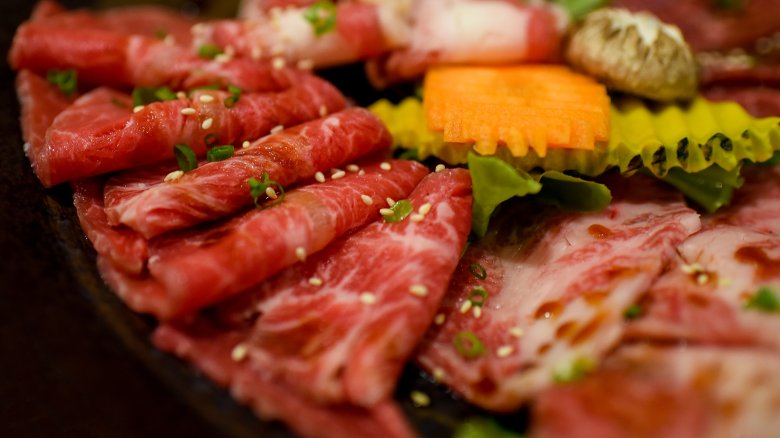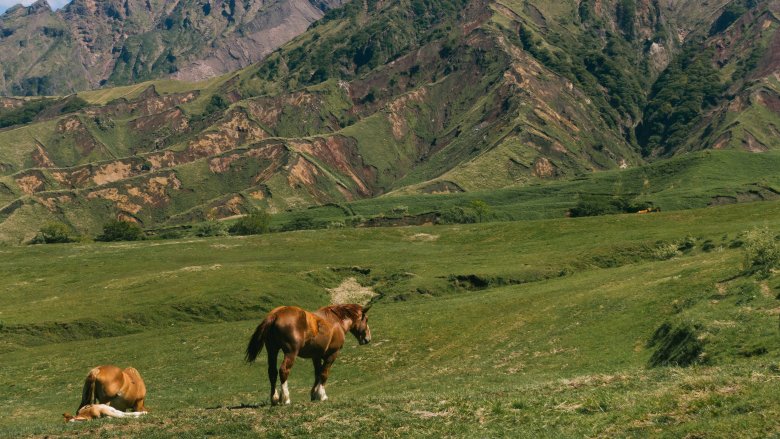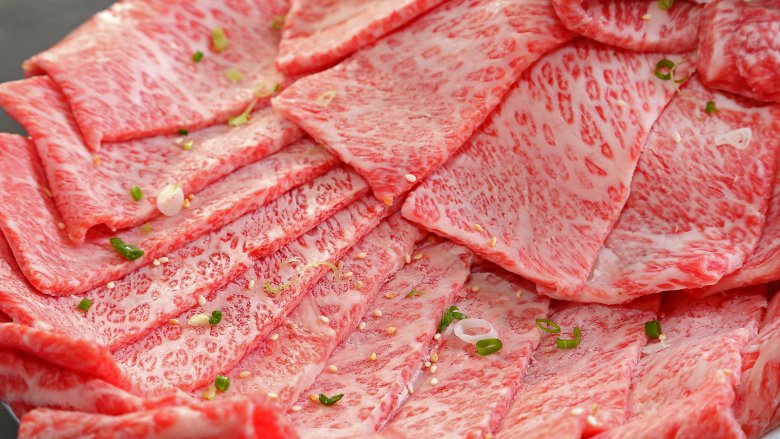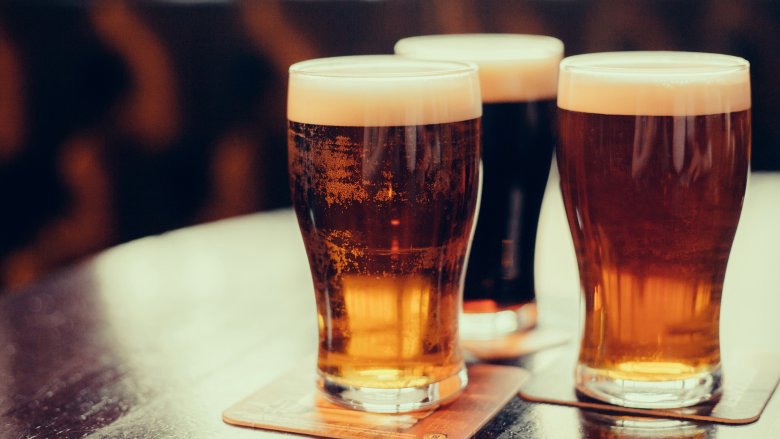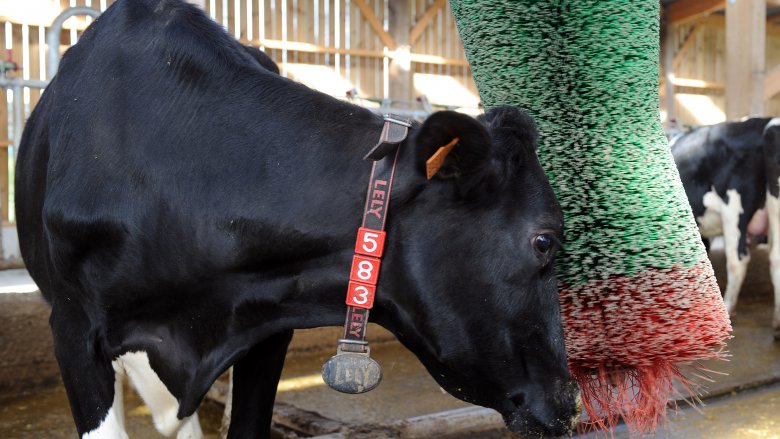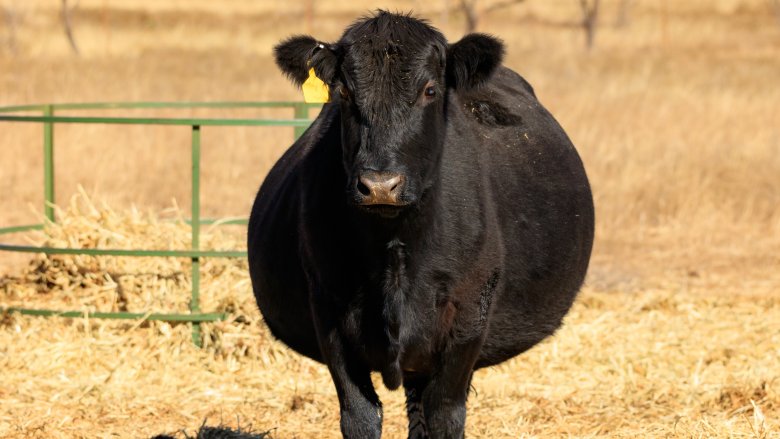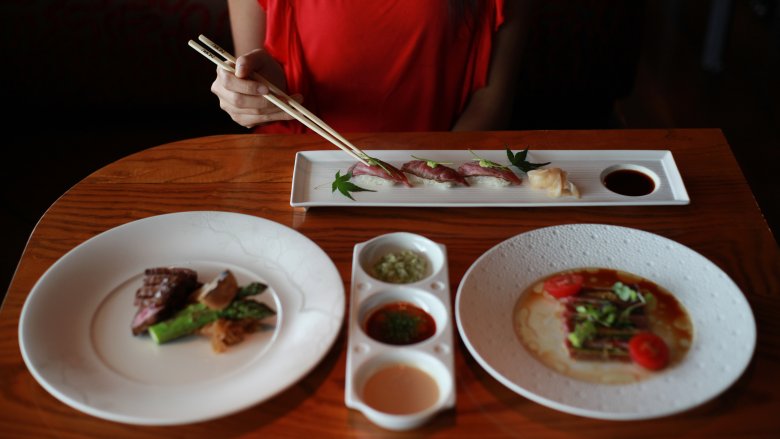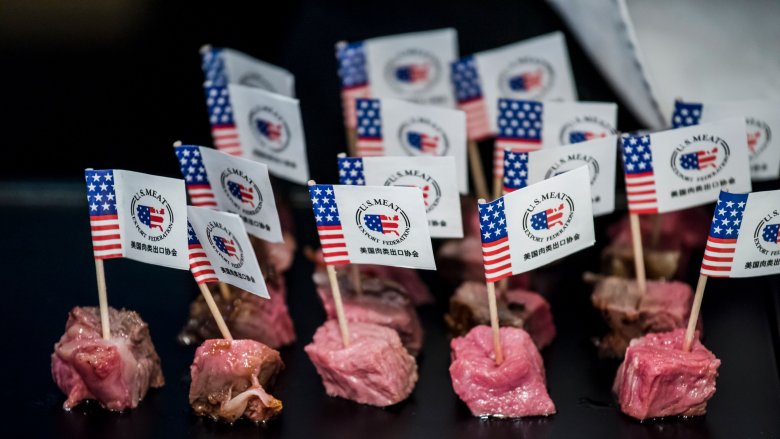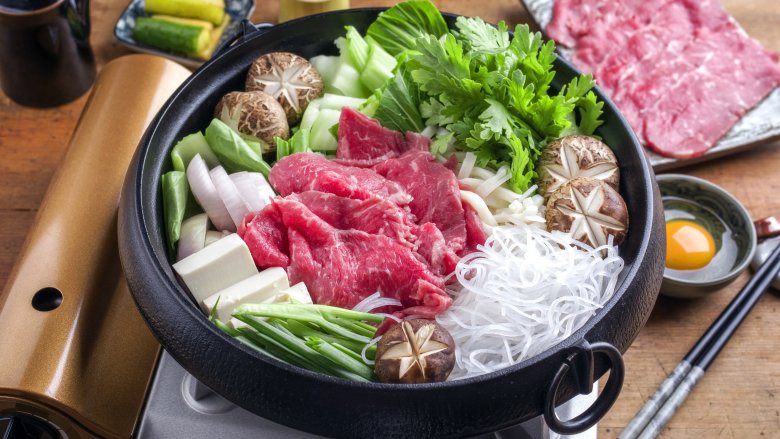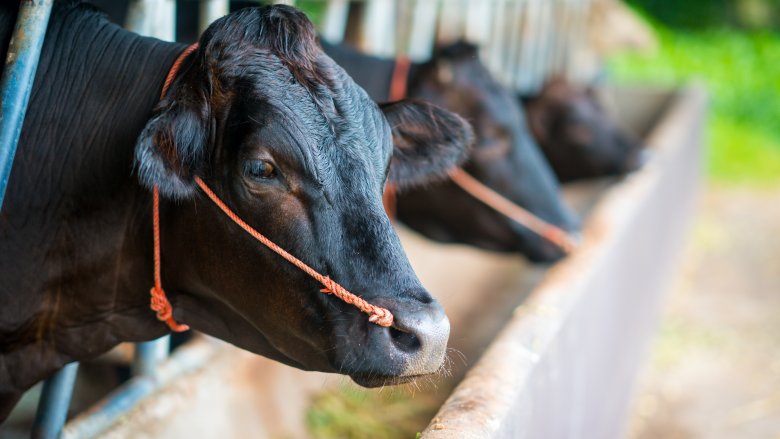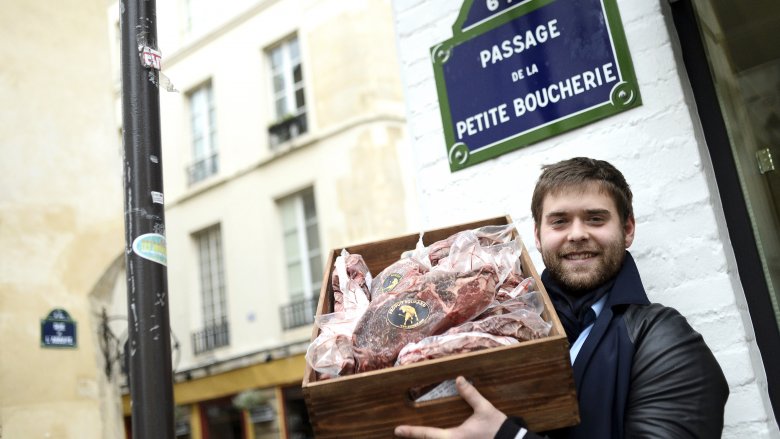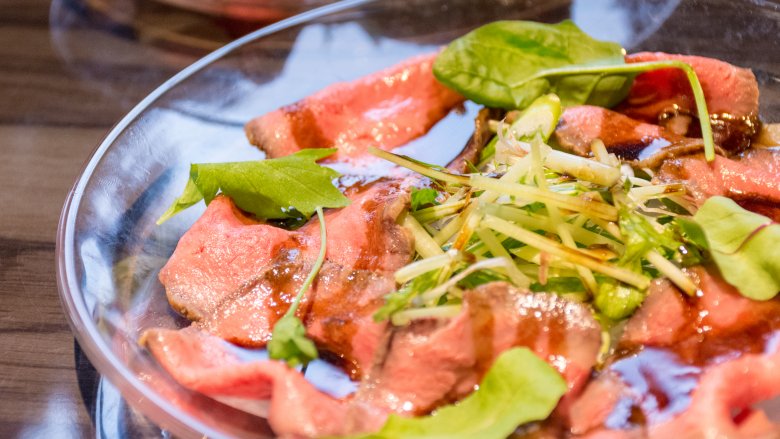The Shady Truth Of Kobe Beef
What's the deal with Kobe beef? If you're a die-hard foodie, you've probably at least heard of this succulent meat, widely considered to be the best beef that money can buy. If you're really lucky, you've even gotten the chance to taste the legendary dish for yourself. If you're like most people, however, you're probably wondering what exactly Kobe beef is. Even most people who think they know the truth about Kobe... don't.
It turns out that Kobe beef has a long and somewhat shady history. Originating in Japan, there are a lot of imitators out there who have caused some confusion surrounding this mysterious meat. To clear this up, we're getting down to the hard facts. What is Kobe beef? Where can you find it? Is it really as amazing as people say it is? Let's find out the answers to these questions and everything else you've ever wondered about Kobe beef.
The popularity of Kobe beef is fairly recent
The consumption of beef in Japan is a fairly recent development in the country's cuisine. Historically, the Japanese people relied on fish as their protein source. For centuries, it wasn't even legal to eat four-legged animals, which included cows. Because of the Buddhist belief that humans could be reincarnated as animals, and the Shinto belief that dead animals make the body impure, there was an aversion to eating meat that extended even beyond the law.
That slowly began to change in 1868, when the city of Kobe became an international port and the consumption of meat became legal soon after. Visitors to the country helped to increase the consumption of beef, but it would be some time before it became a staple of the Japanese diet. After World War II, food shortages forced a major change in Japanese cuisine. The United States, which occupied Japan from 1945 to 1952, started a school lunch program to feed children. This helped introduce children to beef, which in turn led to the growth of the meat industry in the country. Kobe beef had already been popular with foreigners for decades, and its legend only grew as the meat industry took off in Japan.
Are Kobe and Wagyu the same thing?
One of the biggest misconceptions about Kobe beef is that the name can be used interchangeably with Wagyu beef. Wagyu is a beef that comes from one of four breeds of Japanese cows, but are Wagyu and Kobe actually the same thing? "The answer is yes and no," Chef Gerald Chin told First We Feast. "All Kobe is Wagyu, but not all Wagyu is Kobe. Wagyu means Japanese beef. You can't call something Kobe unless it's certified from the region in Japan. If you call the other Wagyus Kobe, it's pretty much like calling California sparkling wine Champagne."
In order to be considered Kobe beef, beef must come from the Tajima-gyu breed of cattle which are born, raised, and even slaughtered in the Hyogo prefecture of Japan, of which Kobe is the capital and largest city. And even if it meets those requirements, it's still subjected to a strict grading policy to guarantee it's only the best quality of meat before it's certified.
No, the Kobe beef cows don't really drink beer (usually)
Kobe beef is so legendary that it can be difficult to separate fact from myth. One of the most widely spread stories about Kobe beef is that the cattle are fed a specialized diet which includes a helping of beer at every meal. The idea of cattle being raised in pampered luxury is part of the public's fascination with Kobe (and all Wagyu in general), but it is not entirely inaccurate.
It is true that there are some farmers who give the cows beer in order to increase their appetites, especially in the summer months when cattle usually eat less. This leads to higher fat levels which in turn makes for a more tender meat. Alcohol is far from a part of the standard diet, though, and most cattle raised for Kobe beef primarily drink water. Nevertheless, the legend persists and many people, including natives of Japan, think that cattle raised for Kobe beef are regularly inebriated.
Cows raised for Kobe beef are pampered
Another myth about cattle raised for Kobe beef is that its tenderness comes from frequently being massaged. Again, this is a myth that has a kernel of truth but that has frequently been misconstrued by the public. Many cows in Japan do, in fact, receive massages, but it's not because it makes them more tender. "These are working cattle," Chef Gerald Chin told First We Feast. "Back in the old days, they used to go out in the field and work really hard. The weather was super cold, so the animals would go back to the pen, and their joints used to literally seize up, like arthritis. The farmers used to pound on the cows so that when they went back out into the field, their joints weren't tight. That's kind of where the massage myth came from." Some cattle raised for Kobe do still get massages, but it's more for comfort than for taste.
One legend that is true about Kobe beef is that the cattle are fed higher quality foods than their American and European cousins. They also listen to music while they eat, something that is supposed to increase their appetite.
It's all about the fat with Kobe beef
Kobe beef has a distinct marbling, which means that the meat has webs of fat that easily melt when heated. It is these deposits of fat that make the beef so tender and give it that "melt in your mouth" quality. Kobe beef is so soft that fine cuts of it are even sometimes served raw. The fat in Japanese cattle is so prized that it is a major component of their meat grading criteria. Japan's Beef Marbling Standard ranges from 1-12, with USDA Prime, which gets America's top marbling grade, ranking only at about a five on the scale. Kobe beef typically ranks much higher, with marbling levels that are beyond anything in the USDA's rating system.
The fat levels of Kobe beef might sound unhealthy, but it's actually the opposite. Kobe beef is filled with unsaturated fats, which have been shown to lower cholesterol levels. Kobe beef is also rich in omega-3 and omega-6 fatty acids, making it among the healthiest red meat that you can consume.
The U.S. banned Kobe beef in the early 2000s
While America's fascination with Kobe beef originated during WWII with American soldiers passing through Japan, it didn't become a nationwide phenomenon until the 2000s. Curiously, the craze coincided with a ban on beef. The U.S. banned Kobe beef, along with all other Japanese beef imports, over concerns about mad cow disease in 2001. That ban was lifted in 2005, but a similar ban was put in place in 2009. Strangely, while Japanese beef was banned in the U.S, the popularity of fake Kobe dishes grew in restaurants all over the country with people thinking they were eating the real, forbidden thing. While some of these restaurants did serve American-style Kobe beef (the result of crossbreeding Japanese cattle with American cattle), the ban ensured that authentic Kobe beef never made it onto menus.
This went on for more than a decade. It wasn't until 2012 that the truth about Kobe was revealed in a Forbes investigation. Later that year, small amounts of Kobe beef were allowed onto American shores, but genuine Kobe beef still remained quite rare.
If you're eating it outside of Japan, there's a good chance it's fake Kobe beef
Cuts of Kobe beef are typically quite expensive due to its rarity, but the Kobe burger you're getting at a local restaurant might not actually be worth the high price tag. While use of the terms "Kobe Beef," "Kobe Meat," and "Kobe Cattle," are all trademarked in Japan so that no one can (legally) pass off other kinds of beef as Kobe, the U.S. doesn't recognize the trademark. This has led to countless restaurants claiming to serve Kobe, banking on their customers not knowing the difference.
According to a list published by Business Insider in 2016, there were only nine restaurants that served authentic Kobe beef in the United States, and they were all in major cities. The official Kobe beef website shows that this list has grown a bit, but it still isn't very common in the U.S. and is mostly served in high-end restaurants.
Even if you find genuine Kobe beef, it might not be prepared authentically
In America, we tend to think of steak as a thick, juicy portion of meat — usually with a bit of a char on the outside. In Japan, however, beef is served much differently, and Kobe is no exception. According to Newsweek, there are only a few classic ways of preparing Kobe: broiling thin strips over a tabletop barbecue, frying thin strips with raw egg, or eating strips dipped in a pot of boiling water. In fact, it's usually served in pieces so small it's easy to eat with chopsticks, and typically only touches the heat for about 40 seconds — a big difference from the knife and fork sawing action you see at American steakhouses.
This makes finding genuine Kobe beef served authentically a difficult feat. Many American restaurants offering Kobe beef cook it up American style — though in smaller servings than the 16-ounce steak you're used to seeing. According to Chef David Walzog, executive chef at SW Steakhouse in Las Vegas, their Waygu steaks (including Kobe) are served in pieces cut about four inches square and cooked low and slow, usually to medium doneness. It's probably delicious, but it's not authentic.
There's not enough Kobe beef to go around
There are a couple of reasons that Kobe beef is so rare in the United States. First, it must meet very specific criteria in order to be certified as Kobe beef. Not only must it come from Tajima-ushi cattle raised on one of just 260 certified farms in Hyogo prefecture, but it must also weigh less than 1,034 pounds in addition to having a certain percentage of carcass to lean fat. In order to ensure standards, all Kobe beef must be processed in a Hyogo slaughterhouse.
According to the Kobe Beef Marketing & Distribution Promotion Association (via Eater), only about 5,000 head of cattle make the cut and are certified as Kobe each year. The supply is made even scarcer in the rest of the world as most Kobe beef is sold within Japan, with only 10 percent or so exported out of the country. In the first 11 months of 2013, just 17 head of Kobe beef were sent to the United States, which averaged out to about 300 pounds a month. To put that into perspective, according to Bon Appetit, the amount of Kobe beef sent to the U.S. each year (as of 2016) was only enough "to satisfy the average beef consumption of just 77 Americans."
Kobe beef is not the most exclusive beef in the world
In spite of all of the fanfare over Kobe beef, it isn't actually the most exclusive beef in the world. That honor, at least according to CNN, goes to world-renowned French butcher Alexandre Polmard. Polmard's family has worked for generations to perfect a meat treatment that involves blowing cold air over the meat in a below-freezing environment, which allows the beef to be preserved indefinitely. The meat is essentially aged like a fine wine, and years-old vintages can go for a jaw-dropping $3,200 per steak.
What else makes the beef so special? For starters, the cows are treated well throughout their lives. "My family wouldn't dream of raising animals in sheds where they have no space or room to roam," said Polmard. "Here they are in the open air, living in forests and on parkland. There are shelters they can choose to visit in case it rains or snows."
Their stress levels are also kept low during slaughter — Polmard even talks to them daily. This leads to a more tender cut of beef as distressed cows see spikes in glycogen and lactic acid which can lead to a loss of tenderness. "All the love and attention we give our animals comes through on the plate when you taste it," said Polmard.
Kobe beef gets a seal
How can you be certain if the Kobe beef you're being served is genuine? The most obvious indicator is price. Kobe beef retails for around $200 per pound at its lowest price, so a place claiming to serve a cheaper Kobe steak is almost certainly lying. Also look closely at the menu. Many of them will tell you where the beef comes from, and specify Hyogo as the origin if it is authentic. The official Kobe website also lists all of the restaurants in the world serving genuine Kobe beef.
You could also ask the restaurant to show you the paperwork, as Kobe beef is accompanied by a certificate verifying its origins, along with a 10-digit ID number and a scannable QR code. These are always in Japanese, though, so they might prove difficult to understand unless you can read the language. If you don't know Japanese, look for the official symbol used to indicate Kobe beef: a round flower surrounded by petals. This symbol is on all paperwork accompanying genuine Kobe beef.
